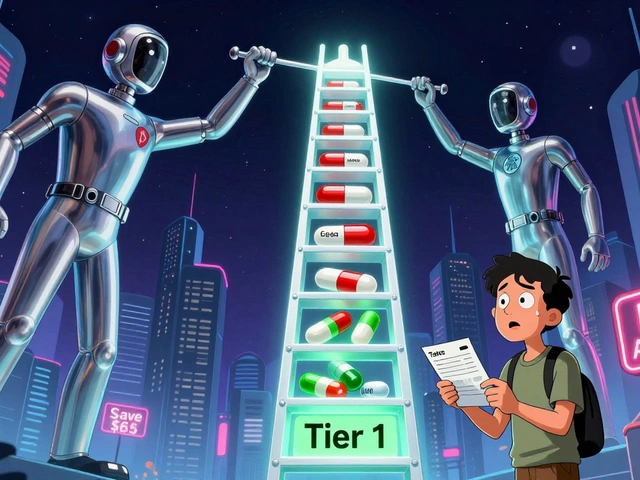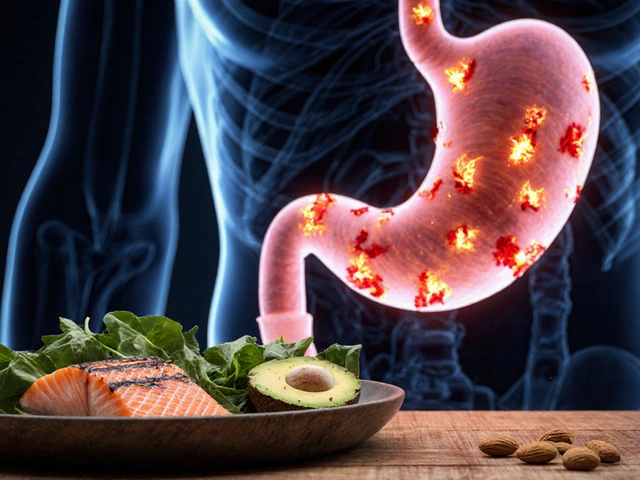
TL;DR
- Carbocisteine is a mucolytic that thins thick mucus, making coughs more productive.
- It’s used for chronic bronchitis, COPD, and sinus infections, typically for 7‑14 days.
- Adult dose: 250mg 2‑3 times daily; children 5‑12y: 125mg 2‑3 times daily.
- Common side effects are mild - nausea, taste disturbance, rare allergic rash.
- Never combine with strong oxidising agents or use if you’re pregnant without doctor approval.
What Is Carbocisteine and How Does It Work?
Carbocisteine belongs to a class of drugs called mucolytics. Think of mucus as the sticky glue that traps germs and dust in your airways. In some illnesses, that glue becomes too thick, turning a simple cough into a painful, unproductive hack. Carbocisteine loosens the glue by breaking down the chemical bonds that make mucus viscous. The result? Thinner secretions that can be cleared more easily by natural ciliary motion.
The drug is taken orally, usually in tablet or syrup form. It’s absorbed quickly, with peak blood levels reached in about 30‑60 minutes. Because it works directly on the mucus rather than the underlying inflammation, it’s often paired with bronchodilators or antibiotics for a fuller treatment plan.
Pharmacologically, carbocisteine is a derivative of the amino‑acid L‑cysteine. Its sulphur‑containing side chain is the key player that disrupts disulphide bridges in mucus proteins. This mechanism is well‑documented in respiratory pharmacology textbooks and aligns with the way other mucolytics, like N‑acetylcysteine, operate.
Common Medical Uses and Who Can Benefit
Doctors prescribe carbocisteine for a handful of conditions where mucus plugs cause trouble:
- Chronic bronchitis: Frequent cough with thick sputum for months.
- Chronic obstructive pulmonary disease (COPD): Helps reduce exacerbations when mucus builds up.
- Sinusitis: Thins sinus secretions, easing drainage.
- Bronchiectasis: Long‑term airway dilation where mucus stagnates.
It’s not a first‑line cure for asthma because the primary issue there is airway hyper‑responsiveness, not mucus thickness. However, many asthma patients who develop a lot of sputum find carbocisteine useful as an adjunct.
Who should consider it? Generally, adults and children over five years old with a confirmed diagnosis of a mucus‑related respiratory condition. Those with a known hypersensitivity to carbocisteine or any of its excipients must avoid it. Pregnant or nursing mothers should only use it under strict medical supervision because safety data are limited.
In Australia, the Therapeutic Goods Administration (TGA) lists carbocisteine as a prescription‑only medicine for most indications, although low‑dose syrups are sometimes available over the counter in pharmacies. If you’re buying it in Perth, ask the pharmacist whether the product is a generic version (often cheaper) or a branded one like Mucosolvan.

Dosage Guidelines and Administration Tips
Getting the dose right matters. Too little won’t thin the mucus enough; too much can cause stomach upset or rare allergic reactions. Below is a quick reference that follows the most recent TGA prescribing information (2024 update).
| Age Group | Strength | Typical Dose | Frequency | Maximum Daily Dose |
|---|---|---|---|---|
| Adults (≥18y) | 250mg tablet | 250mg | 2‑3times/day | 750mg |
| Children 5‑12y | 125mg tablet or syrup 125mg/5ml | 125mg | 2‑3times/day | 375mg |
| Children 12‑17y | 250mg tablet | 250mg | 2‑3times/day | 750mg |
Take the tablet with a full glass of water; the syrup can be measured with the calibrated spoon that comes in the bottle. For best effect, swallow after meals-food buffers the stomach and reduces nausea.
If you miss a dose, take it as soon as you remember, unless it’s almost time for the next scheduled dose. In that case, skip the missed one; don’t double‑up.
Short‑term courses (7‑14days) are standard for acute infections. For chronic conditions like COPD, doctors may prescribe a maintenance dose that you’ll take indefinitely, but they’ll reassess every few months to check for efficacy and side effects.
Special advice for seniors: kidney function declines with age, so the doctor might lower the dose or increase the interval between doses. Always have your blood work checked if you’re on long‑term therapy.
Safety Profile: Side Effects, Interactions, and Frequently Asked Questions
Carbocisteine is generally well‑tolerated, but no drug is completely risk‑free. Below is a snapshot of what you might experience and how to handle it.
- Common (1‑10% incidence): Nausea, mild abdominal discomfort, altered taste, loose stools.
- Uncommon (0.1‑1% incidence): Skin rash, itching, dizziness.
- Rare (<0.1% incidence): Anaphylaxis, severe liver enzyme elevation.
If any reaction feels severe-especially breathing difficulty, swelling of face or throat-seek emergency care immediately.
Drug interactions are not extensive, but keep these points in mind:
- Antioxidants such as high‑dose vitaminC may theoretically reverse the mucolytic action, although clinical evidence is weak.
- Concomitant use of strong oxidising agents (e.g., certain chemotherapeutics) can increase the risk of bronchospasm.
- Alcohol doesn’t directly interact, but it can worsen stomach irritation.
Now, let’s address some of the questions people usually ask after reading about carbocisteine.
Can I use carbocisteine for a common cold?
For a typical cold, the mucus is often thin enough that you don’t need a mucolytic. Over‑the‑counter expectorants may be sufficient. Reserve carbocisteine for cases where the sputum becomes thick, sticky, and hard to clear.
Is carbocisteine safe while breastfeeding?
Data are limited, but small studies suggest low transfer into breast milk. Many clinicians consider it compatible with breastfeeding if the infant shows no adverse effects. Still, discuss it with your GP.
What should I do if I forget a dose?
Take it as soon as you remember, unless it’s almost time for the next scheduled dose. In that case, skip the missed dose-don’t double up.
Can carbocisteine help with asthma symptoms?
Only if you have a lot of mucus (e.g., during an asthma‑related infection). It won’t relax the airway muscles, so you’ll still need your inhaler.
Why does my mouth taste metallic?
The sulphur‑containing structure of carbocisteine can leave a faint metallic or “cabbage‑like” taste. It’s harmless and usually fades after a few days.
Lastly, if you experience persistent side effects or no improvement after a full course, contact your healthcare provider. They may need to adjust the dose or explore alternative therapies such as nebulised hypertonic saline or physiotherapy techniques for mucus clearance.

Next Steps and Practical Tips for Getting the Most Out of Carbocisteine
Here’s a quick checklist to ensure you’re using the medicine safely and effectively:
- Confirm the diagnosis with your doctor-don’t self‑prescribe.
- Ask for the exact formulation (tablet vs syrup) that fits your lifestyle.
- Set a reminder on your phone to keep dosing consistent.
- Pair the medication with plenty of fluids; water helps thin mucus further.
- Monitor any side effects in a journal; share this with your GP at follow‑up.
- Review your need for ongoing therapy every 3‑6months.
By following these steps, you’ll maximize the benefit of carbocisteine while keeping risks low. Remember, the medicine works best when you combine it with good breathing practices-slow, deep breaths, occasional chest physiotherapy, and staying hydrated.
If you’re in Perth and need a prescription, your local GP can write one electronically. Many pharmacies now offer same‑day pickup, and some even provide a home‑delivery service for chronic meds. Keep your prescription date handy, as the TGA requires a refill only after a minimum 30‑day interval.
Stay informed, ask questions, and don’t hesitate to reach out to a qualified health professional if anything feels off. Your lungs will thank you.
Joanne Beriña
This is why American healthcare is broken. They're giving out mucolytics like candy while people can't afford insulin. Who even prescribed this? Some pharma rep with a free lunch?
Hardik Malhan
Carbocisteine works by cleaving disulfide bonds in mucin glycoproteins via its thiol group. Not magic. Just chemistry. Dont overhype it.
Kelsey Worth
i legit thought this was a new vape flavor at first 😅 my bad
shelly roche
If you're dealing with thick mucus and this helps you breathe easier without a bunch of side effects, that's a win. Listen to your body and talk to your doc. You got this 💪
Benedict Dy
The TGA prescribing guidelines are outdated. This drug has been shown in multiple RCTs to have negligible impact on exacerbation rates in COPD when used alone. The placebo effect is stronger than the pharmacology here.
Jasper Arboladura
You people don't understand the pharmacokinetics. Carbocisteine's bioavailability is highly variable due to first-pass metabolism. Most patients are getting subtherapeutic doses because they're not fasting. This isn't even a real treatment-it's a placebo with a molecular structure.
John Power
I had chronic bronchitis for years and carbocisteine was the only thing that made coughing bearable. No drama, no hype-just worked. Glad it's helping others too 🙏
Emily Nesbit
The article omits that carbocisteine is contraindicated in patients with peptic ulcer disease. This is a critical omission. Medical misinformation is dangerous.
Richard Elias
this stuff is just a fancy cough syrup. why are we even talking about it like its a miracle drug? 🤡
Jeremy Mattocks
I've been on carbocisteine for 8 months now for bronchiectasis and honestly it's been a game-changer. Before this, I was in the ER every 6 weeks with pneumonia. Now I'm down to maybe once a year. The nausea faded after the first week, and I take it with food like they said. It's not glamorous, but if you're stuck with thick mucus that won't clear, this is one of the few things that actually helps. Don't let the skeptics scare you off-talk to your pulmonologist, track your symptoms, and give it a real shot. It's not a cure, but it's a tool. And sometimes, that's enough.
ABHISHEK NAHARIA
In India, we have better alternatives. Mukaltin is cheaper, more traditional, and works just as well. Why are we importing expensive Western drugs when Ayurveda has been managing kapha congestion for centuries? This is cultural imperialism disguised as medicine.
Scott McKenzie
Just started this last week for my COPD and already feel less wheezy 🙌 Took it with breakfast like the doc said-no nausea so far. Also, drink water. A LOT of water. It helps the mucus move out better. #LifeHack
Casey Nicole
I can't believe people are actually defending this. My cousin took this and ended up in the hospital with a rash that looked like a spider bite. They didn't even warn him. Big Pharma is poisoning us and you're all just nodding along like good little patients
Nirmal Jaysval
bro carbocisteine is just a fancy way to say you're coughing up boogers. why are we making this sound like rocket science? just drink tea and stop smoking lol
Paul Baker
i took this for my sinus infection and it worked way better than the antibiotics my dr gave me 🤯 i feel like a genius now
Zack Harmon
THIS IS A SCAM. I SAW A VIDEO ON TIKTOK WHERE A DOCTOR SAID CARBOCISTEINE IS JUST WATER WITH A CHEMICAL NAME. THEY'RE MAKING BILLIONS OFF PEOPLE WHO CAN'T READ. I'M STARTING A PETITION.
Emily Rose
To everyone saying this is useless or dangerous: I’ve been on this for 2 years with bronchiectasis. I’ve had zero hospitalizations since starting. It’s not perfect, but it’s kept me alive. If you’re skeptical, try it under supervision. Don’t dismiss it because you don’t understand the science. We’re not all just blindly taking pills-we’re trying to breathe.





Write a comment